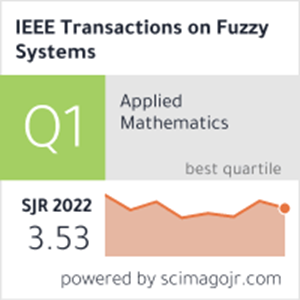基于嵌入真值聚类图的一步模糊集成聚类方法
IF 11.9
1区 计算机科学
Q1 COMPUTER SCIENCE, ARTIFICIAL INTELLIGENCE
引用次数: 0
摘要
在多源聚类任务中,每个源或视图中的集群数量可能与真实集群的数量不一致。现有的集成聚类方法面临着两个显著的挑战:1)开发一个新的集成框架,产生与真实聚类数相匹配的最终聚类结果;2)揭示所有基础聚类结果之间的一致性。为了解决这些挑战,我们提出了一种新的一步模糊集成聚类方法(OS-FECM),该方法结合了真聚类数图。最初,OS-FECM建立了一个一步模糊集成框架,直接集成具有不同聚类计数的所有基本模糊聚类结果(即隶属矩阵),从而消除了对现有两步集成框架典型的协关联矩阵的依赖。此外,我们构造了一个基础真聚类数图,将每个基本聚类结果中的聚类数映射到最终集成结果中的基础真聚类数。该图显示了所有基本模糊聚类结果之间的一致性,并说明了基本结果中的聚类与基础真值聚类之间的关系。然后将其嵌入到相应的基本模糊聚类结果中,以增强最终的集成结果。最后,我们采用交替优化方法和加权机制来获得最终的集成聚类结果,并自适应地为每个基本聚类结果分配重要性。跨各种数据集的实验评估表明,OS-FECM实现的聚类性能至少与其他比较方法相当,如果不是优于其他方法的话。本文章由计算机程序翻译,如有差异,请以英文原文为准。
One-Step Fuzzy Ensemble Clustering Method via Embedding Ground-Truth Cluster Number Graphs
In multisource clustering tasks, the number of clusters in each source or view may not align with the number of ground-truth clusters. Existing ensemble clustering methods face two notable challenges: 1) developing a new ensemble framework that yields a final clustering result matching the ground-truth cluster count and 2) revealing consistency among all base clustering results. To address these challenges, we propose a novel one-step fuzzy ensemble clustering method (OS-FECM) that incorporates ground-truth cluster number graphs. Initially, OS-FECM establishes a one-step fuzzy ensemble framework that directly integrates all base fuzzy clustering results (i.e., membership matrices) with varying cluster counts, thereby eliminating reliance on the coassociation matrix typical of existing two-step ensemble frameworks. Furthermore, we construct a ground-truth cluster number graph, which maps the number of clusters in each base clustering result to the ground-truth cluster count in the final ensemble result. This graph reveals the consistency among all base fuzzy clustering results and illustrates the relationships between clusters in the base results and the ground-truth clusters. It is then embedded into the corresponding base fuzzy clustering results to enhance the final ensemble result. Finally, we employ an alternating optimization method alongside a weighting mechanism to derive the final ensemble clustering result and adaptively assign importance to each base clustering result. Experimental evaluations across various datasets demonstrate that OS-FECM achieves clustering performance that is at least comparable to, if not superior to, that of other comparative methods.
求助全文
通过发布文献求助,成功后即可免费获取论文全文。
去求助
来源期刊

IEEE Transactions on Fuzzy Systems
工程技术-工程:电子与电气
CiteScore
20.50
自引率
13.40%
发文量
517
审稿时长
3.0 months
期刊介绍:
The IEEE Transactions on Fuzzy Systems is a scholarly journal that focuses on the theory, design, and application of fuzzy systems. It aims to publish high-quality technical papers that contribute significant technical knowledge and exploratory developments in the field of fuzzy systems. The journal particularly emphasizes engineering systems and scientific applications. In addition to research articles, the Transactions also includes a letters section featuring current information, comments, and rebuttals related to published papers.
 求助内容:
求助内容: 应助结果提醒方式:
应助结果提醒方式:


